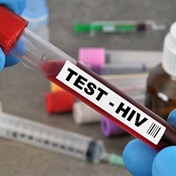People with HIV are much more likely to develop bone disease, or be on their way to developing it, a new study shows.
In a group of people with HIV, researchers found eight in 10 had either osteoporosis, the brittle-bone disease that raises the risk of fractures, or osteopenia, abnormally low bone mass that could progress to osteoporosis.
It's unclear exactly why people with HIV are more likely to experience bone loss, study author Dr Anna Bonjoch of the Lluita contra la SIDA Foundation in Barcelona, Spain, told.
Virus affects bones
HIV-positive people have the same risk factors as anyone else, but the virus itself may affect bones, as may some drugs used to treat it. However, the fact that some drugs may increase the risk does not mean people should opt out of taking them, she cautioned.
"To stop the treatment is not an option," Bonjoch, whose findings appear in the journal Aids, said.
Some risk factors for bone loss - such as age - are impossible to change, Bonjoch added, but there are steps people can take to reduce their risk, or prevent existing problems from worsening.
For instance, HIV-positive people can stop smoking, reduce their intake of alcohol, stay physically active, get enough calcium in their diet, and keep the virus under control.
The findings
Osteoporosis is a disease that increases with age, primarily affecting women over 50. According to the International Osteoporosis Foundation, one in three women and one in five men over 50 will experience fractures due to osteoporosis.
The overall rate of low bone density among the general population varies by age and country, Bonjoch explained, but likely falls around five %.
However, in this study, half of the participants were 42 or younger, suggesting HIV put them at higher risk of bone problems. Indeed, previous research has suggested that people with HIV are three times more likely to develop bone loss than the general population.
From earlier bone scans in 671 HIV-positive patients, Bonjoch and her team found 23% had osteoporosis, and another 48% had osteopenia.
Osteopenia
Among the 105 participants who had received more than one scan and were followed for at least five years, nearly half experienced a worsening of their bone thinning, progressing to osteopenia or osteoporosis.
Even though women are typically at higher risk of developing bone loss, men in this study had double the risk. Other factors linked to bone loss included being underweight, older, and spending more time on the HIV drug tenofovir.
These risk factors match what previous studies have shown, Dr Todd Brown of Johns Hopkins University, who did not participate in the study, told.
Higher rate of bone loss
But the rate of bone loss is significantly higher, he said, suggesting the patients were not representative of the overall HIV population.
One explanation could be that patients with bone loss might be more likely to get scans, Brown said.
But the general trend is clear, he added: "The percentage of patients with osteoporosis with HIV infection is probably higher than you would expect in an HIV-negative population."
Brown said HIV patients also appear at higher risk of heart disease, cancer, kidney problems, diabetes, and cognitive decline. "All these big chronic diseases that increase with age do occur earlier in HIV," he said. (Reuters Health / November 2010)
Read more:
Bone loss basics
Who is at risk for osteoporosis?
Osteoporosis and your diet




 Publications
Publications
 Partners
Partners














